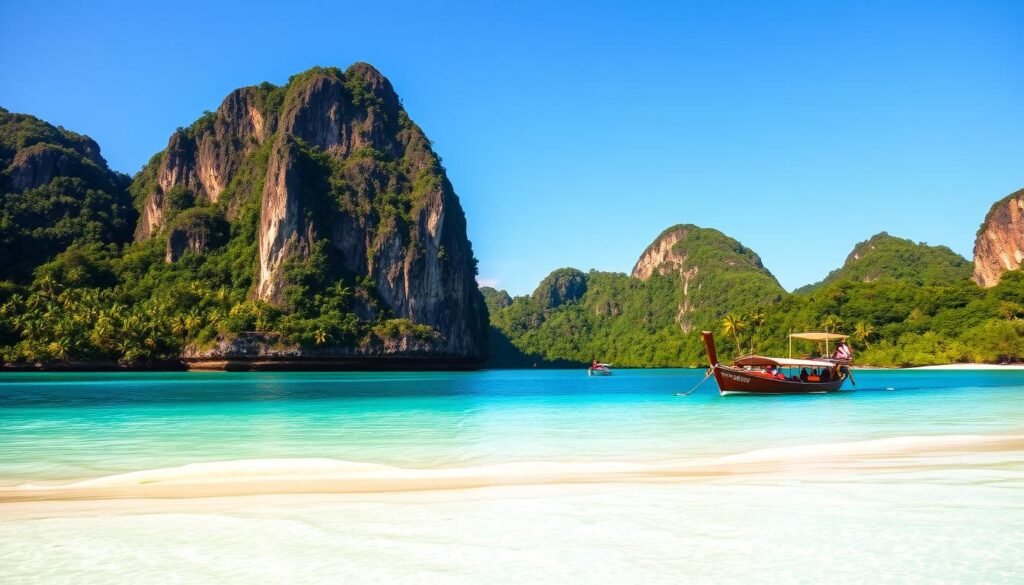One surprising fact: over 39 million travelers arrive each year, yet you can still find quiet corners if you plan your route right.
I’ll give you a practical game plan for my next trip, so you hit top islands and beaches without zigzagging across the country. I start in the capital city and move north to culture-packed Chiang Mai, then sweep down to Andaman and Gulf islands — my favorite way to experience this destination.
I point out world-class temples you shouldn’t miss, like the Emerald Buddha, and share real timing tips for short flights and easy overland links. Dress modestly at temple sites, carry Thai Baht (THB), and remember late November to February is the best weather window countrywide.
I’ll also show where I stay, how I move around, and when I swap resort days for scooter days. This intro sets a clear, friendly route so your trip feels effortless and rewarding.
Key Takeaways
- I map a one-way route: Bangkok → Chiang Mai → islands and beaches.
- Expect short flights (Phuket ~1 hour, Chiang Mai ~75 minutes from Bangkok).
- Late November–February is the best time for most of the country.
- Pack modest clothes for temples and carry local currency (THB).
- Use this linked guide for a quick list of top spots and travel tips: Thailand highlights.
Why I Put This Curated List Together for Your First (or Next) Thailand Trip
I mapped these stops around real travel rhythms, so your days feel smooth and not stuffed with long transfers.
My goal was simple: cut through the noise and show a clear way to link the highlights. I flag timing, when to rest, and which city suits your energy on day one.
This country is welcoming, budget-friendly, and rich with food and culture. Peak season runs November through February. Avoid Chiang Mai’s burning season in February and March for air-quality reasons.
I focus on walkability, local food scenes, and the vibe that tells me a destination truly works. Use this as a flexible backbone whether you have one week or more time for your trip.
| Why I Pick It | When to Go | How It Links |
|---|---|---|
| High food and culture value | Nov–Feb (peak) | Short flights and easy trains |
| Great walkability and markets | Avoid burning season Feb–Mar | Pairs well with northern loops |
| Relaxing coastal options | Sunrise/sunset timing matters | Island hops or direct ferries |
“This guide shows the most efficient routes and the moments worth lingering for.”
Bangkok: Temples, River Life, and Night Vibes in the Capital
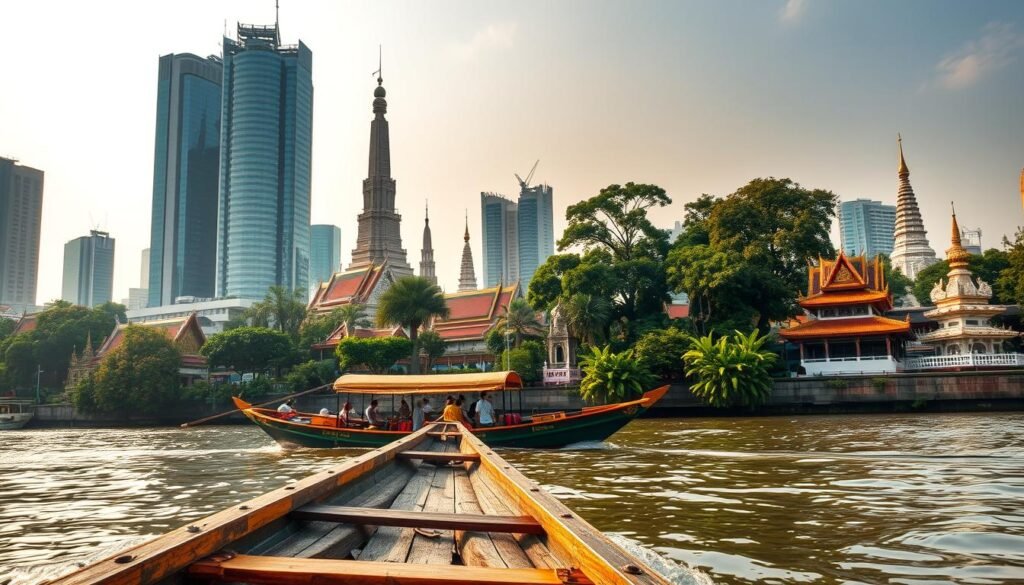
My routine in the capital is simple and reliable. I start early, hit a few key sites, take a river break, then keep the night low-key.
Grand Palace & Wat Phra Kaew: Home of the Emerald Buddha
I arrive at the Grand Palace when it opens (roughly 8:30 am) to avoid crowds and heat. Admission is about 500 THB and the dress code is strict—cover knees and shoulders.
The Emerald Buddha is the highlight; I wear a light cover-up and move slowly through the grounds to savor the details.
Wat Pho & Wat Arun: Temple of Dawn and the Reclining Buddha
Wat Pho opens earlier, around 8:00 am, and costs about 200 THB. I always pair a temple walk with a short traditional Thai massage there—perfect after a flight.
Crossing the river by ferry to see wat arun is easy. Wat arun welcomes visitors roughly 8:00 am–6:00 pm and has a small admission fee.
Chao Phraya Boat Ride: Klongs, Royal Barges, and Riverside Views
A longtail boat ride along the Chao Phraya and the klongs shows a quieter side of the city. Stops can include the Royal Barges Museum and riverside photo spots.
Where I Stay and How I Get Around: BTS, river piers, and neighborhoods
I base myself near BTS lines or river piers for fast hops. Taxis by meter or Grab beat tuk tuks for value and speed.
For food, I follow busy street stalls or head to indoor food courts to cool off. At night I prefer a riverside dinner or a short market stroll—then early rest for the next day.
“Glittering temples, river life, and neon nights coexist in one capital.”
Chiang Mai: Old Town Charm, Mountain Temples, and Night Bazaars

Chiang Mai feels like a slow, sunlit city where temples, markets, and mountain air meet.
Old City is just a 1.5 km square with a moat and bits of ancient wall. I stay inside or just outside so I can walk to Wat Chedi Luang and snack-hop my favorite khao soi stands.
Where I go for views and short trips
I time Wat Phra That Doi Suthep for sunrise or golden hour and don’t mind the 306 steps for the panorama.
My top easy day trip is Bua Tong, the “Sticky Waterfall.” The rock is grippy, so no gear is needed. For cooler trails I add Doi Inthanon on longer stays.
Markets, festivals, and getting around
The Night Bazaar stretches over 1 km and is perfect for crafts and casual eats. If you love festivals, plan travel for Songkran (mid-April) or Yi Peng (November) for lantern magic.
- I pick small-group tour options for tight schedules.
- Use red songthaews, Grab, or a scooter when traffic allows.
- Food draws me back: khao soi, northern sausage, and café hopping in Nimman.
“This city blends temples, cafés, and markets with the right pace for an easy northern loop.”
Chiang Rai: The White, Blue, and Black Temples Plus the Golden Triangle
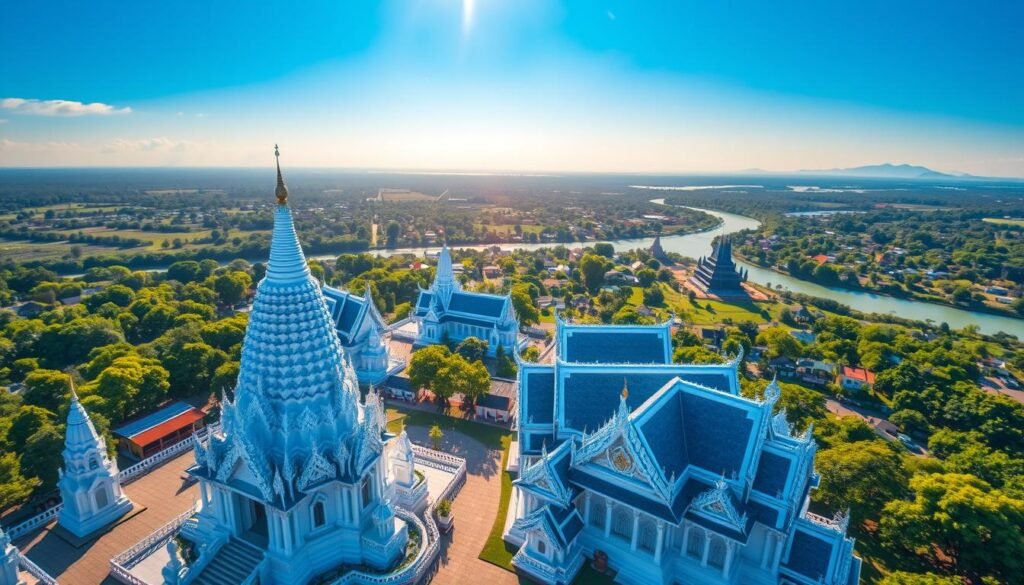
I slow my pace in Chiang Rai to read the symbolism carved into modern temple art and rural scenes.
I come for the art-infused temples: the gleaming surfaces of Wat Rong Khun and the vivid blues at Wat Rong Suea Ten. Wat Rong Khun is an ongoing project by Chalermchai Kositpipat and charges a small entry fee (~50 THB).
These sites reward a slow walk-through. Wat rong pieces mix myth and modern motifs, so I take time to notice details rather than rush photos.
Contrasts: Baan Dam and countryside trips
Baan Dam (the Black House) by Thawan Duchanee feels intentionally darker and more provocative. I set expectations for themes that might unsettle kids and choose visiting times that suit our group.You can learn best-islands-to-visit
I also build a countryside day to the Golden Triangle. Rolling fields, Mekong viewpoints, and small villages make the region feel far from Chiang Mai’s bustle.
- I arrive early at wat rong khun for quieter moments.
- I time dinner at the night bazaar to watch the clock tower light show.
- Connections from chiang mai are easy by bus or car for a smooth northern loop.
| Site | Highlight | Visitor Tip |
|---|---|---|
| Wat Rong Khun (White Temple) | Modern, white symbolic art | Small fee, arrive early for fewer crowds |
| Wat Rong Suea Ten (Blue Temple) | Vivid blue murals and serenity | Combine with nearby cafes for a relaxed morning |
| Baan Dam (Black House) | Provocative, edgy art complex | Expect darker themes; not ideal for very young kids |
“I find Chiang Rai a thoughtful pause — artful temples, a mellow night scene, and quick countryside escapes.”
The Mae Hong Son Loop: A Scenic Northwestern Thailand Road Adventure
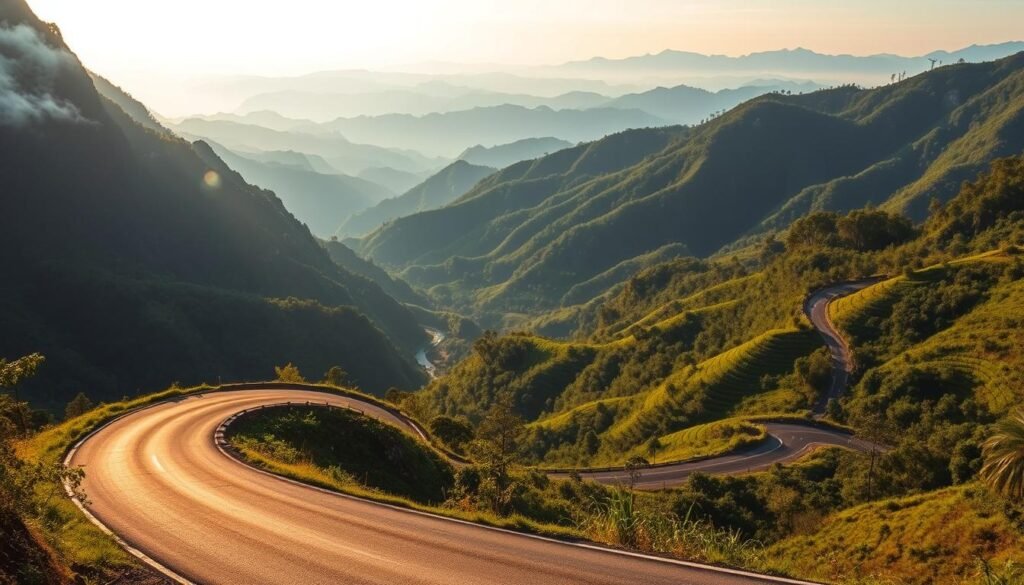
A winding road up northwest from chiang mai reveals misty valleys and honest small towns that reward slow travel. The loop is nearly 400 miles of curvy mountain roads, so most riders treat it as a multi-day trip.
Pai, mountain passes, and clockwise route tips
I ride the loop clockwise to warm up on flatter sections before tackling steep passes. That way I gain confidence early and save the tightest bends for later.
My routine splits days for short hikes, cafés with valley views, and hot springs around Pai. I book simple guesthouses for weekend nights and stay flexible on weekdays.
- I pack layers—temperatures swing by elevation and time of day.
- If I skip riding, shared vans still offer scenic views with less effort.
- I plan fuel stops, carry cash, and avoid night riding for safety.
“This route proves the north is a road-tripper’s dream and shows that memorable places lie well off the beaten path.”
| Feature | Why it matters | Tip |
|---|---|---|
| Clockwise route | Easier road sections early | Build confidence before steep passes |
| Multi-day pace | Time for hikes, hot springs, and cafés | Split into short segments for relaxed days |
| Logistics | Remote stretches need planning | Book guesthouses, plan fuel, bring cash |
Pai: Hot Springs, Waterfalls, and Canyon Views with a Boho Heart

I build a half-day of waterfalls and a sunset stop at Pai Canyon whenever I want to unwind. Tha Pai hot springs are my midday reward after a cool morning walk to Pam Bok or a longer trek out-and-back to Mae Yen.You can learn /best-time-to-visit-cancun
The walking street buzzes at night, so I usually sleep just outside the center and stroll in for food and live music. Shared vans from chiang mai work well when I skip a scooter—less stress on curvy roads and more time for the view.
I plan one full day for a longer hike, or a half day if I only want several small water stops. Simple tours bundle hot springs, caves, and viewpoints; I pick small groups that start early and avoid midday crowds.
- I use Pai as my nature-and-chill stop: morning waterfalls, midday hot springs, sunset at Pai Canyon.
- If I’m on a scooter I respect the roads: no night riding and easy speeds on descents.
- For souvenirs I shop the night market later in the evening when the food scene ramps up.
“Pai is where I loosen the itinerary—some places earn a slow day, and this is one of them.”
Phuket: Entry-Level Island Bliss with Hidden Mangroves and Beaches
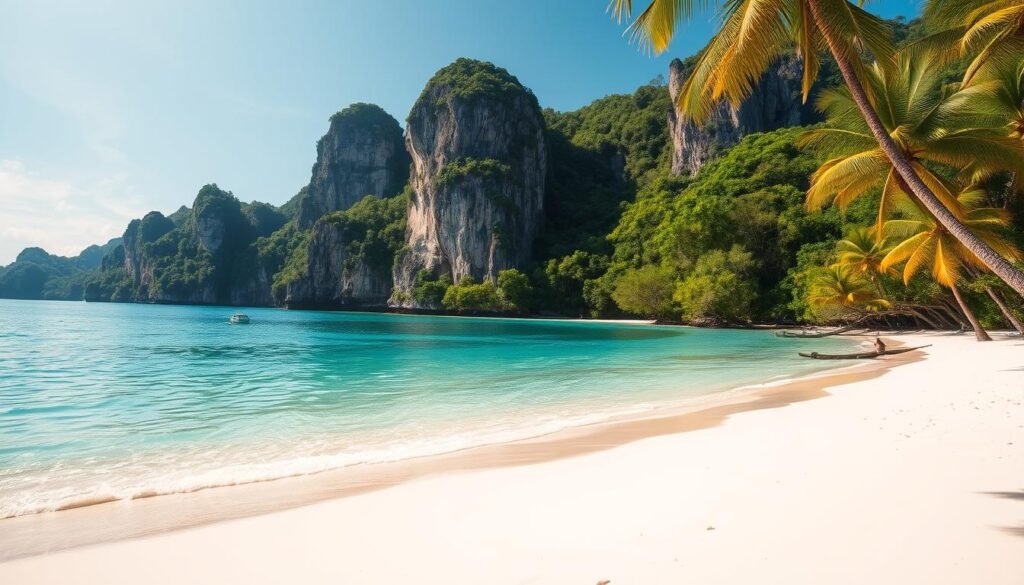
Phuket makes a handy gateway for island exploration, but I often push past the busy strips for quieter coastal corners.
Quick reality: Phuket is Thailand’s largest island and a major flight hub — roughly 300 flights a day. Patong draws big crowds, so I plan at least one day there for the nightlife and then move on.
Beyond Patong: Where I find quiet sands and coastal viewpoints
I ride a scooter to Bang Tao or Pansea for calmer beaches and small viewpoints. For nature, I wander parts of Sirinat National Park and respect nesting zones.
Resort Time vs. Scooter Time: Picking your perfect island day
On full-rest days I pick a resort with a strong pool and beach access and let myself do nothing. On exploration days I rent a scooter, scan coastal viewpoints, and book an early boat trip to Phang Nga Bay or ferries to nearby islands.
“Phuket is both an easy island entry point and a launchpad for quieter bays and boat trips.”
| Why I go | Where I stay | How I move | Tip |
|---|---|---|---|
| Flight access and variety | Resort with beach or Phuket Old Town guesthouse | Scooter for short runs; taxis for groups | Plan by area — cross-island drives eat time |
| Nature and mangroves | Near Sirinat National Park | Short hikes and coastal rides | Respect nesting zones and park rules |
| Island hopping hub | Port-side stays for early departures | Book early boat trips to beat crowds | Choose morning ferries for calmer seas |
Krabi & Railay: Limestone Cliffs, Caves, and Emerald Waters
![]()
Krabi’s coastline blends soaring limestone with hidden coves, and I plan my days here around short boat runs and tide charts so I don’t miss a cave or lagoon. The area has lively Ao Nang for launches and quieter coves that reward an early start.
Railay by Boat: Rock climbing, beach time, and sea caves
I take the longtail boat to Railay for a full day of beach-hopping and cave exploring. The ride is roughly twenty minutes and it always feels cinematic as cliffs rise from the water.
My Railay routine is simple: an early boat, a morning on the sand, an optional climbing lesson, then a late lunch with a view. I watch climbers scale sheer limestone and peek into sea caves at low tide.
Tip: carry a dry bag for camera gear and check tide charts if you plan lagoon entries.
Tiger Cave Temple Stairs and hot springs day trips
If I want a workout, I climb Wat Tham Suea’s 1,260 steps for a panoramic sunrise. The effort is worth it—views open up across karsts and coastal flats.
Nearby, I slot a half-day for the natural hot springs and the Emerald Pool (Sa Morakot). Water is clear and oddly refreshing; I bring water shoes for rocky entries.
- I use Krabi as a base—there’s an airport and quick boats to surrounding islands for easy connections.
- I prefer small-group tours for caves and lagoons; they save time and add safety on crowded sites.
- For beaches I split time between Railay’s coves and Ao Nang’s launch point depending on the mood of the day.
For extra planning, I check local guides and Krabi activities & tours for schedules and small-group options that match my pace.
“Limestone, clear water, and quick boat runs make this slice of southeast asia feel like a postcard worth lingering in.”
Koh Phi Phi: Iconic Bays, Snorkeling Sites, and Island Hopping
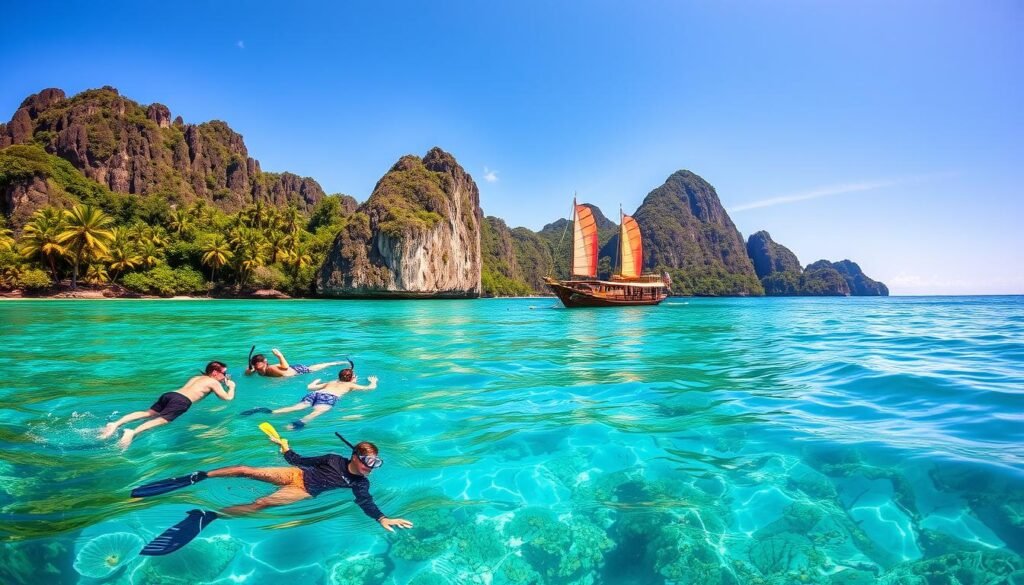
I time my Phi Phi runs for early light—when coves feel private and reefs look their truest blue.
Phi Phi Don is the only island with hotels; nearby Phi Phi Leh sits inside a national park and holds Maya Bay’s famous view. I split my day by boat between snorkeling stops, tucked-away coves, and a short pause near Maya Bay for photos.
For snorkeling I always ask operators about timing and gear quality. That small check usually makes or breaks the experience.
Divers find strong sites around the islands, so I book reputable shops in advance during busy months. If seas get choppy, I switch a full tour for a half-day and keep plans flexible.
- I base on Phi Phi Don when I want a lively night and an early departure.
- Day trips from Phuket or Krabi work well if I prefer no overnight logistics.
- I pack reef-safe sunscreen, hydrate between swims, and shoot photos early or late for softer light.
“Phi Phi delivers crowd-pleasing highlights in one compact island group—plan, pace, and you’ll get the best of it.”
Koh Lanta: Laid-Back Beaches, Mangroves, and Longtail Boat Days
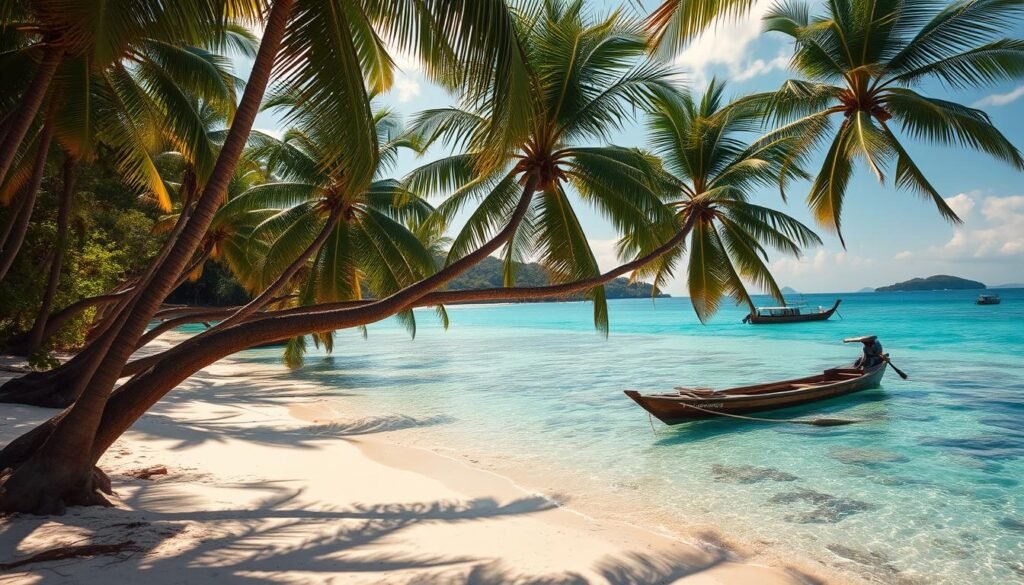
Koh Lanta slows my pace with wide sands, mangrove creeks, and easy longtail rides. I come for easy beach days and simple offshore snorkeling that feels flexible and low-key.
Lanta Old Town is my half-day wander: wooden houses, quiet sea views, and calm cafés where I try local food and sip coffee. I often join a cooking class—Time for Lime is a feel-good option that supports a dog shelter.
I rent a scooter to hop between shores. Roads are light and short distances make exploring stress-free. For snorkeling, I hire a longtail with a captain so stops match sea conditions.
Resorts here lean relaxed. I book one with good beach access and sunset views instead of packing the schedule. I carry cash for small vendors and bring reef-safe sunscreen and a rash guard for offshore time.
- I favor flexible boat rentals and small mangrove tours.
- Lanta feels like home on a scooter—quiet bars, friendly crews, and easy tour options.
| Feature | Why I like it | Practical tip |
|---|---|---|
| Lanta Old Town | Traditional wooden houses and sea views | Visit mid-morning for calm cafés and shade |
| Longtail boat trips | Custom offshore snorkeling stops | Hire a captain and check reef conditions |
| Mangrove paddles | Quiet nature and birdlife | Bring cash and a light waterproof bag |
“This island’s rhythm is unhurried—perfect for lazy days, little discoveries, and slow afternoons on the water.”
Khao Lak: Under-the-Radar Andaman Base for Diving and Jungle Trails
Khao Lak is my quiet launch point for clear-water days and jungle hikes along the Andaman coast.
When to go: I plan Khao Lak trips between January and April. Seas are calm, the light is sharp, and day tours to the Similan and Surin islands run at full speed.
Practical note: Similan Islands Marine National Park usually closes from May 15–October 15 for protection, so I lock in diving and snorkeling trips early in the season.
Why I base here and what I do
I choose Khao Lak when I want world-class diving without island party scenes. I book dive boats well ahead—spots disappear fast when conditions are perfect.
- Snorkeling and diving: clear water and healthy reefs make short boat trips rewarding.
- Beach days: Khao Lak’s beaches are pleasantly uncrowded, ideal for lazy mornings and late swims.
- Onshore options: I hike Lam Ru National Park for jungle-and-coast views on rest days.
Transfers are easy—tours commonly offer hotel pickups from Khao Lak, Phuket, and Krabi. I prefer the right operator over the closest dock and always pack a dry bag and seasickness meds for longer island runs.
“Khao Lak balances beaches, boats, and trails in exactly the right proportions when I want serious water time without the crowds.”
Khao Sok National Park: Floating Bungalows, Karsts, and Jungle Wildlife
Khao Sok feels like a world where rainforest meets water and every morning starts with bird calls. I come for the karst towers and the slow rhythm of life on Cheow Lan Lake. The national park’s reservoir is human-made, but the scenery feels timeless.
Cheow Lan Lake: Overnights on the water and guided wildlife spotting
I always try to spend a night in a floating bungalow—those raft houses turn the national park into my backyard. Mornings are for misty paddles, gibbons calling, and quiet wildlife watching along limestone walls.
I book guided boat tours at dawn and late day. Those hours make the lake feel like another world. If I have only one option, a day tour still shows the signature views, but overnight magic is my pick.
| Activity | Why it works | Tip |
|---|---|---|
| Overnight bungalows | Near wildlife and calm water | Bring a dry bag and light jacket |
| Kayaking & cave trips | Close-up karsts and caves | Follow ranger guidance for safety |
| Dawn boat tours | Best chance for sightings | Book small-group operators that support conservation |
“Khao Sok is where Thailand’s wild side shines—lush rainforest, calm water, and nights that hum with life.”
I treat this spot like a home away from home when I need raw nature during my travel. If you love lakes, limestone, and slow days on the water, it will feel like your island of quiet in a busy world.
Khao Yai National Park: Easy-to-Reach Wilderness Near Bangkok
A short drive from Bangkok opens a world of thick forest, misty ridges, and real wildlife encounters. Khao Yai was Thailand’s first national park, and its scale and habitat remind me of a Southeast Asian cousin to the Great Smoky Mountains.
Wildlife highlights and how I get there by public transport
I pick Khao Yai when I want big wildlife chances without a long travel day from the capital. Buses and trains run to Pak Chong; a short taxi brings me to trailheads or a nearby lodge.
Wildlife is the star: elephants, gibbons, barking deer, and shy leopard cats. I plan a guided day trip for the highest odds of sightings and book a lodge that arranges early starts and park entry help.
Trails range from easy walks to longer hikes. I match my hours on foot to daylight and weather, carry binoculars, a light rain layer, and insect repellent, and keep expectations flexible—wildlife is wild.
Khao Yai guide is handy when I sort schedules and transfers. It’s my favorite quick nature break when city life needs a green reset.
“You don’t have to go far from the city to feel deep in the Thai wilderness.”
Ayutthaya: A UNESCO World Heritage Day Trip from Bangkok
Ayutthaya sits about 50 miles north of the capital and feels like an open-air museum. The old city once ranked among the world’s largest urban centers, and rivers form an island dotted with over 500 ruined temples.
I treat Ayutthaya as the perfect day trip for temple lovers. I rent a bicycle near the park and follow a DIY route, or I join a guided tour for history and context. That way I cover 3–5 key sites without rushing.
Temple-hopping by bike or boat
Wat Chaiwatthanaram is my must-see—grand, photogenic, and quieter early in the morning. I save a late afternoon boat ride around the island for sunset; rivers light the riverside ruins beautifully.
- I carry sun protection and water—hours among exposed ruins add up fast.
- A guide adds stories you won’t get from signs alone.
- I time the return train or bus to skip city rush hour and save time the next day.
“Ayutthaya balances accessibility and depth—a world heritage stop you can do well in a single, time-efficient day.”
For planning and logistics I follow an Ayutthaya day trip guide that lists schedules and local options.
Sukhothai: Ancient Ruins, Buddha Statues, and Peaceful Park Rides
A morning pedal through Sukhothai’s ruins feels like stepping into a living history book.
Sukhothai was Siam’s first capital in the 13th–14th centuries and has nearly 200 ruins spread across a calm, bike-friendly park. I rent a bike at the entrance and glide between brick chedis, lotus ponds, and reclining Buddhas.
Si Satchanalai & Kamphaeng Phet: Off-the-beaten-path world heritage
Si Satchanalai Historical Park and Kamphaeng Phet Historical Park share the same unesco world heritage designation and feel far quieter than Ayutthaya. Vendors are limited inside core zones, so the mood stays peaceful.
I often start with a short tour for context, then spend my day roaming solo. Early light and late afternoon offer the best shots of chedis and lotus reflections.
- I pack sunscreen and a picnic—shade comes and goes between temple clusters.
- Sukhothai is calmer than Ayutthaya and perfect for a relaxed day of temple-hopping.
- Add Si Satchanalai for solitude and beautiful Buddha statues; Kamphaeng Phet fits as a half-day round‑out.
“I linger at one favorite wat rather than racing through a list of sites.”
Best places to visit in thailand: My Themed Shortlists for First-Timers
I narrowed my favorite stops into themed shortlists so planning a trip feels simple and flexible.
Culture & Temples
Bangkok, Ayutthaya, Sukhothai, chiang mai, chiang rai — this loop pairs grand palaces and UNESCO ruins with northern temple art. For modern temple art, don’t miss wat rong khun (the white temple) outside chiang rai.
Beaches & Islands
Mix a flight hub like Phuket with Krabi/Railay’s cliffs, Koh Lanta’s calm shores, Koh Phi Phi’s bays, or Koh Samui for Gulf resorts. If snorkeling matters, add Similan/Surin from Khao Lak or a longtail off Lanta.
National Parks & Nature
Khao Sok’s floating bungalows deliver lake magic. Khao Yai is an easy national park day trip from Bangkok. For winding mountain loops, I use routes near chiang mai for scenery and riding.
Off the Beaten Path
I love Rayong’s wetlands boat rides and mangrove boardwalks, Uthai Thani’s dazzling Wat Tha Sung and wooden Wat Tham Khao Wong, and Kanchanaburi’s river retreats and Sangkhlaburi’s Mon village.
| Theme | Highlights | Why I pick it |
|---|---|---|
| Culture & Temples | Bangkok, Ayutthaya, Sukhothai, chiang mai, chiang rai | Rich history, buddhist temples, easy day trip options |
| Beaches & Islands | Phuket, Krabi/Railay, Koh Lanta, Koh Phi Phi, Koh Samui | Varied sand, snorkeling, boat access, resort choices |
| National Parks & Nature | Khao Sok, Khao Yai, Mae Hong Son loop | Wildlife, lake overnights, scenic drives |
| Off the Beaten Path | Rayong wetlands, Uthai Thani temples, Kanchanaburi | Quieter experiences, local culture, unique landscapes |
“This shortlist helps me tailor an itinerary: more islands for beaches, more ruins for history, or more parks for wild time.”
Conclusion
Travel across this country can feel like a well-told story. With the right timing—late November–February for most regions and February–March for Koh Samui—you’ll hit clear skies and calm seas. The world here rewards slow afternoons and early starts.
I often start in the capital, drift north to chiang mai for temple calm, then unwind south. For big sites I plan an early visit and save the hottest part of the day for shade or a swim.
Use BTS and river boats in the city and metered taxis for short hops. Trains are scenic but often late. I pick an eSIM (Airalo) for short trips and AIS for longer stays.
If you love one spot, you’ll find reasons to return. Make room in your plan, and this country will quickly feel like home.


